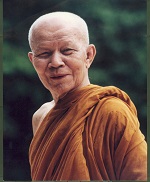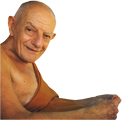[TBT] About the Thai Forest Tradition
The Thai forest tradition is summarized in this quote from Luangta Maha Bua:
"This is the Lord Buddha's teaching: 'rukkhamūla-senasanam' - retreating into the forests and mountains. After ordaining as a monk, one should, according to 'rukkhamūla' go and live under the shade of a tree, in the forest, in the mountains, caves, or under rocky overhangs. These are places conducive to the practice, where one will not be disturbed. Your practice there will progress comfortably, smoothly and well. There you should practice diligently and with perseverance for the rest of your life!"
The Thai forest tradition of Lungphu Sao and Lungphu Mun
The Thai forest tradition was founded by Lungphu Sao and Lungphu Mun, 
In the West, Lungphu Chah is probably the best known representative of the Thai forest tradition, and he is generally considered to have also been a disciple of Lungphu Mun. Technically, however, he was from the Maha Nikaya tradition within Thai Buddhism whereas Lungphu Mun was from the Thammayut tradition. Lungphu Chah went to visit Lungphu Mun on one occasion for three days to consult on his Dhamma practice, and subsequently respected and revered Lungphu Mun as his teacher. For this reason, he is generally regarded as a disciple of Lungphu Mun. However, he had never been trained by Lungphu Mun personally, whereas all of Lungphu Mun's other well known disciples (from the Thammayut tradition) had been trained by him, most of them over many years; Luangta Maha Bua, for example, was trained personally by Lungphu Mun for nine years. With this in mind, one would expect there to be significant differences between the Dhamma Vinaya of the Forest Tradition taught by Lungphu Mun (and his successor Luangta Maha Bua) and that taught in the tradition of Lungphu Chah.
The western disciples of the Thai forest tradition
The first western monk ordained in Thailand in the Thai forest tradition was Ajahn Paññavaddho, who came to live with Luangta Maha Bua in 1963. In fact, Ajahn Paññavaddho had first come to Thailand seven years before with two other western monks to be ordained in the Maha Nikaya tradition, but the others left within a year, and Ajahn Paññavaddho returned to England as a bhikkhu. At his second visit, he asked a friend to find the best meditation master in Thailand, and he was directed to Luangta Maha Bua. A couple of years later, Ajahn Cherry came to stay at Luangta Maha Bua's monastery, and both bhikkhus were ordained in the Thammayut tradition in 1965, becoming disciples of Luangta Maha Bua at Baan Taad forest monastery.

The representation of the Thai forest tradition in the West
A search of the Internet for information about the Thai forest tradition leads to a variety of articles, including an overview on Wikipedia. From these, one might assume that the leading western representative of the Thai forest tradition is Ajahn Sumedho, since Lungphu Chah's teachings were the first to become physically established in the West, becoming popular among Westerners and spreading all over the globe through the efforts of Ajahn Sumedho and his disciples. This raises the question of why much less has been known in the West about the western disciples from the Thammayut tradition of Lungphu Mun and Luangta Maha Bua. There are probably many reasons, but the most important are that the Lungphu Mun tradition emphasizes solitary practice in forests, favours a very austere mode of living, and puts primacy on spiritual attainment, as the following incident well illustrates. In 1974 Luangta Maha Bua was invited to England, and was accompanied by Ajahn Paññavaddho and Ajahn Cherry. At the end of the visit, Ajahn Paññavaddho was entreated by British laypeople to remain in England, and he asked Luangta Maha Bua if he should stay. Luangta Maha Bua then asked him, "Are you finished with your work?". With this, Ajahn Paññavaddho returned to Thailand with his mediation master, never to return to England again. Luangta Maha Bua's interest was in the spiritual well-being of his disciples, and in their efforts to 'finish their work' rather than in publicizing or spreading his teachings (or Buddhism in general) to the West.
 |
Ajahn Paññavaddho (1925 - 2004) - disciple of Luangta Maha Bua. |
 |
Ajahn Cherry - disciple of Luangta Maha Bua. He was ordained the same day as Ajahn Paññavaddho. Still living at Wat Pa Baan Taad, he is now the most senior western bhikkhu in Thailand. He does not like to teach and avoids the public. |
 |
Ajahn Thanissaro - disciple of Lungphu Fuang and Ajahn Suwat. More information: dhammatalks.org or wikipedia |
 |
Ajahn Dick Sīlaratano - disciple of Luangta Maha Bua More information: forestdhamma.org |
 |
Ajahn Martin Piyadhammo - disciple of Luangta Maha Bua |